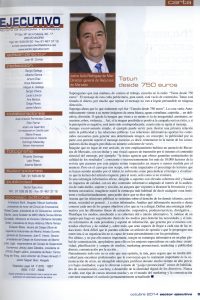Let’s suppose that one morning, on your way to work, you hear on the radio: “Tatun from 750 Euro”. For you, the message of this commercial is empty of content. Tatun is throwing money away, no matter how much they repeat the message, they are not going to persuade you in any direction.
 Suppose now that what you really heard was “Cancun from 750 euros”. It’s a different story. Images of white sand, crystal-clear waters, caipirinha… in short, fun, automatically comes to mind. Or perhaps the image that comes to mind is one of insecurity: murders, kidnappings, robberies, violence… Thus, if the perceived image is positive, the campaign will be a success, and if the perception is negative, it will be all the more counterproductive, the more the message is repeated.
Suppose now that what you really heard was “Cancun from 750 euros”. It’s a different story. Images of white sand, crystal-clear waters, caipirinha… in short, fun, automatically comes to mind. Or perhaps the image that comes to mind is one of insecurity: murders, kidnappings, robberies, violence… Thus, if the perceived image is positive, the campaign will be a success, and if the perception is negative, it will be all the more counterproductive, the more the message is repeated.
Although excessively simple, this example can serve to illustrate an initial relationship between advertising and public relations. Information relations provide the necessary content to generate a certain image, a concept; advertising, on the other hand, allows us to repeat the essential message, in other words, to recall this perceived image in the minds of consumers a sufficient number of times.
Imagine that instead of this article, on this site there were a Recursos de Mercado ad with a headline and a visual capable of conveying the essential content of the message, for example: “the only agency that offers contractual guarantees of quality results”; consciously or unconsciously, the more than 10,000 readers of Executive Sector who pass by this page would be impacted to a greater or lesser extent by the ad. But in this case, only the percentage of readers who have been attracted by the headline, enough to devote the time and effort required to read the article, will be impacted; for the rest, it will be as if it did not exist.
If an effective information strategy, aimed at media with high useful coverage and based on quality impacts, with a high information content adapted to the interest of the audience of each media, outlet and section, does not ensure that we will achieve the necessary frequency and coverage; imagine the more usual strategy of saying anything insistently and indiscriminately, in order to say that something is being said.
Assume that public relations is based on the right of others (customers, shareholders, society in general…) to be informed. Analyse what information each of the target groups you are going to address needs or wants to know. Define an information strategy with the different lines of action: corporate, product/service, informative… Plan the media, taking into account their useful coverage and informative interest. And, surround yourself with a team that monitors the media on a daily basis to detect the needs and news interest of each journalist and information support, that generates effective and quality content on their own and, above all, that is capable of reaching each of the newsrooms. It will be difficult to be asked for an opinion article or to be offered an interview if your organization is not able to deal personally with journalists.
Last but not least, integrate your information strategy into an overall communication plan, relying on the best specialists in each area: creativity, media planning and buying, promotional marketing, direct marketing and advertising, action communication…
Naturally all this is just my opinion, but I am sure you will have no difficulty in finding professionals who convince you that what is really important is crisis communication, an ideal intangible to justify a high price and/or low results for a long time; or who offer you as a “promotional gadget” courses in communication skills, coaching or development of the digital identity of managers. You never know, these types of courses are very decorative and in the world of marketing and communication it is a good idea to keep your curriculum constantly updated.
Jaime Ávila Rodríguez de Mier
General Director of Recursos de Mercado
Published by Sector Ejecutivo october 2014




